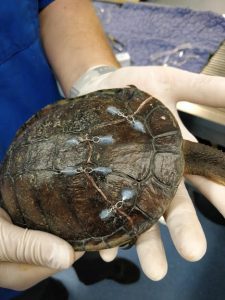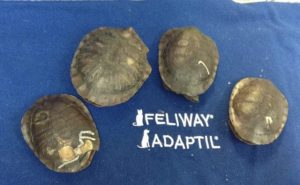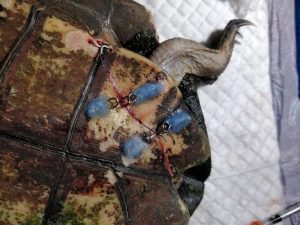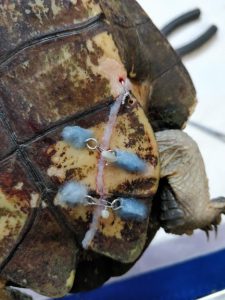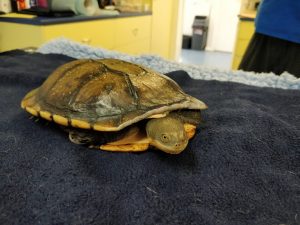What animal has no teeth but needs dental fillings?
Turtles of course!
Motor vehicles strikes account for a large proportion of the injured wildlife we see at Inner South Veterinary Centre. Unfortunately our native Long Neck Turtles are common victims of incidents with cars on our roads. With lots of rainy days turtles are on the move, which often means crossing busy roads. The most common injuries we are presented with in turtles are broken or fractured shells.
The first step:
Fortunately with appropriate veterinary care, the majority of injured turtles can go on to be rehabilitated, and as with all rehabilitated wildlife, ultimately released back into the wild. Over the last few months we have treated several wild turtles suffering from shell fractures. Most were presented to us by wildlife care groups, members of the public as well as from other vet clinics.
The first step is to assess the individual turtles and the extent of their injuries. Typically this involves giving strong pain relief and a thorough examination. X-rays are also routinely taken and can be very helpful in determining if the turtle is carrying eggs. Critical welfare decisions are made at this stage: some injuries are too extensive to repair, and in these cases humane euthanasia is necessary.
Fractured shells:
Turtle shells are essentially living flattened bony plates with an outer covering of nail-like keratin. The shell helps protect their vital organs and structures. There are various methods of repairing broken shells but the basic principles of fracture treatment in other species apply.
Shell repair:
We first start by giving appropriate pain relief as well as fluids and warmth. The fractures are often initially stabilised using bandages and tape – this helps protect exposed tissue and reduces pain. The next important step before permanently stabilising the fractures is to ensure that any contaminants – algae, dirt, water, infected tissue is removed from breaks. This can take days to weeks of bandage changes, ointments and cleaning. During this time ‘dry docking’ or keeping the turtles out of the water is employed, as open fractures and water do not mix! As turtles cannot eat out of the water, they often require to be tube fed and given fluid injections during this time. Antibiotics are also important to treat or prevent infection of the contaminated bone. The majority of debridement, or thorough cleaning, of the fracture is done under general anaesthesia. This is the less glamorous aspect of treating broken shells but is actually the most vital. If infection is trapped under an otherwise good repair, this may not become evident for months to years afterwards, possibly after the turtle is released back into the wild.
There is more than one way of fixing a broken turtle shell and creativity is encouraged! We gather ideas at exotic animal vet conferences and workshops and use a variety of methods. These include external loops and wires attached to the shell using glues, pipe clamps with epoxy resin, as well as orthopaedic wires placed through holes drilled into the periphery of the shell. This part of the shell repair is what reduces the fracture and provides strength and stability to allow for natural bone healing. As with all things turtle – healing can take many, many months.
The last step is to seal the fractures. In past this was done using resins and other composites. Unfortunately this often trapped bacteria and leached toxins into the surrounding tissues. Sealing the shell allows the turtles to be returned into the water while the bones heal which avoids long periods of dry docking and means that some individuals can be returned to the wild far sooner.
Is there a material purpose-made for this application? In some ways, yes there is!
We use human dental composite donated by dentists. These materials can be quickly cured using special lights, are safe to be in contact with living tissues, kill bacteria and are extremely durable. As long as special care has been taken to decontaminate the wounds these materials make the fractures waterproof meaning the turtles can enjoy a relatively normal life while healing up and getting ready for release!
After care and release:
All of this would not be possible without the wonderful and dedicated volunteers of local wildlife care groups such as ACT Wildlife and Wildcare NSW who put a lot of time and effort in rehabilitating these animals back to full health before being ready to be released back into the lakes, dams and rivers of Canberra and the surrounding regions.

